Foreign Treaty Ports in China 1557-1999
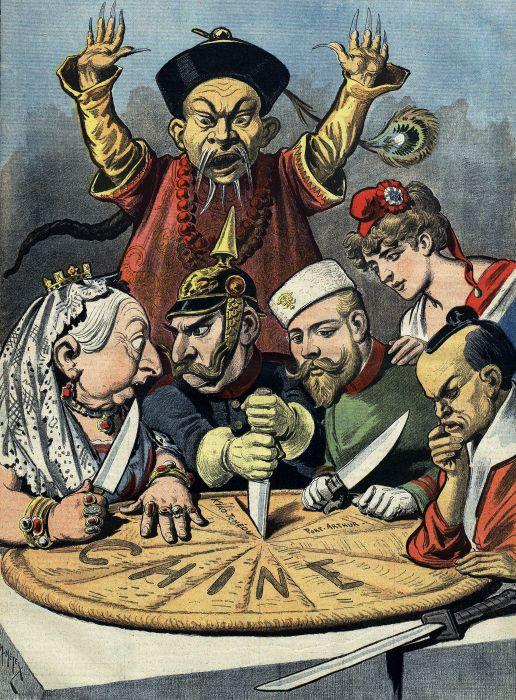
Foreign Treaty ports, Concessions and Enclaves
The coming of foreign nations to China in the period 1840-1940 marks a low point in Chinese power. The foreigners set about founding their own communities within China, subject to their own laws and customs, living as if still at home. It was a foreign occupation of China in all but name. At one time nearly every major city in China had such a ‘community’. The early Chinese perspective was of foreign tribes of barbarians endlessly squabbling amongst themselves, they hoped that they would attack each other rather than the Chinese, as indeed was to happen in World War 1. One view is that the Qing dynasty preferred the foreigners to be contained in separate areas as that allowed the Chinese government to limit contact with ordinary Chinese. Macau, from as early as 1557, served as the model of how a foreign enclave should be administered and contact contained.
Foreign run cities in China
They were usually termed ‘treaty ports’, but there were cities that were not ports and some were not signed away in a treaty. Where the city had an exclusive area set aside for foreigners this was called an ‘enclave’ but in cities with fewer foreigners they lived among local Chinese people in ordinary housing. They were also called ‘concessions’ suggesting they were given away by agreement, again this was not always the case. A ‘concession’, was a foreign leasehold where land could not be subleased back to the Chinese and only selected Chinese were allowed to enter. Shanghai is a classic example, it became a treaty port in 1842 at the Sino-British Treaty of Nanjing which ended the First Opium War. There were also cities such as Nanning, Guangxi that were given away by China without a treaty as the government foresaw that they would soon be forced to do so and could forestall a hostile take-over by giving up control voluntarily on its own terms.
Although the foreigners were supposed to restrict themselves to living solely within the enclave many did explore the wider area. In the heat of summer many took a trip to inland mountains just like the British did in India where Shimla ➚ became a favored retreat. Guling near Mount Lushan in Jiangxi province was a favorite ‘Hill Station’ for Shanghai dwellers and also Kuliang in Fuzhou.
However there were also ‘possessions’ where a foreign government had bought the land and all rights in perpetuity. The clearest example of this is Hong Kong island. In the later stages of the Qing dynasty, foreign occupancy was not restricted to cities, large areas of land were purchased under lease such as parts of Shandong and Guangdong. Just as important as the cities were the railways that were nearly all owned and run by foreign powers, they acted as corridors of control linking the treaty ports.
Foreign laws and customs
Many of the foreigners, even missionaries, continued to live under their own traditions and customs with little interest or contact with the local Chinese around them. They set up social and sports activities just as they would do at home. The local people just provided the domestic servants. For police and militia, the British brought in Indians and Africans rather than using local people. The glimpses of these little bubbles of Western culture within China enabled many local Chinese to appreciate both their own demeaning status but also some advantages of the foreigner's culture. The main language of discourse between foreigners and Chinese for the period 1750-1870 was pidgin English. In the early days most foreigners were single men on a short posting to China (one or two years), however after about 1870 postings became permanent and whole families moved to China and required housing and amenities.
The most important westerner in the story of treaty ports is Sir Robert Hart (1835-1911) ➚ a man who came to be trusted by both the Chinese and westerners. The most senior members of the Chinese Imperial court called him ‘Our Hart’ even though he was born in Ulster. He administered the collection of taxes on foreign trade with fairness, discretion and honesty and worked as a trusted employee of the Chinese government. He supervised the opening up of many of the treaty ports choosing the personnel to run the excise and customs offices. The tax he collected for the Qing government was invaluable, enabling them to pay off the interest on the ruinous indemnities exacted by foreign powers over the Opium Wars. He spoke and wrote Chinese fluently and knew all the traditions. He was a fine arbiter of disputes that took place between the two sides. One of the key reforms he introduced was the building of a series of lighthouses on the sea routes to China (especially the South China Sea). These made sea voyages considerably safer as shoals and reefs could be avoided and navigation was possible even in poor weather (particularly in typhoon season). However not all westerners took this friendly approach to relations with China as in the case of Horatio Lay.
Chinese Legations
Another concession squeezed out of China in the Treaty of Nanjing after the First Opium War was the establishment of permanent legations in Beijing. Previously all requests for this had been denied as it suggested the foreign nations were to be considered the same as the Chinese Empire. The Emperor was considered ‘Lord of All under Heaven’ and so this was not acceptable until the matter was forced on him by armed conflict. The legation quarter ➚ adjoined the south-east corner of the Forbidden City. Great Britain took the largest legation at the prime spot closest to the Forbidden City - now the home of the Ministry of State Security. Soon a brass band was playing and the legation had its own wells, doctor and chapel. When the British built chimneys on their buildings the locals were dismayed by the bad Feng Shui. By 1898 Britain had 64% of all trade with China in contrast to the US which then only had 8%, so Britain was the main foreign power at this time. The legation quarter was resented by local people and it came under siege at the end of the Boxer Rebellion.
Extra-Territoriality
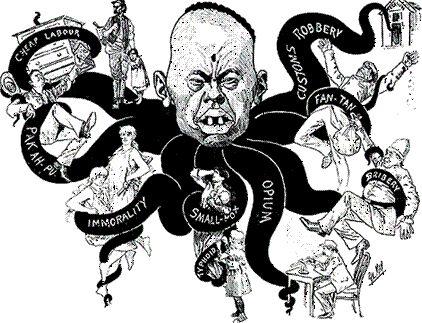
In the larger concessions foreigners lived in their own settlements under foreign not Chinese law. Churches, hotels and clubs were built and a police force formed, all financed by a local taxation system. Many of these brick and stone buildings survive, most notably at The Bund, Shanghai, Tianjin and Wuhan. In the early days many Chinese visitors came to look at this strange alien style of architecture as it was being erected. However in the less important treaty ports, foreigners did not create their own separate area but lived among the Chinese.
Although the land was still owned by China, full rights were taken by the foreign power including, most importantly, the justice system. Crimes committed within the treaty port were tried under foreign law in a foreign administered court. There was even a ‘British Supreme Court in China’ set up in 1904. This was the principle of ‘Extra-Territoriality ➚’ which lasted 1842-1943. These courts tended to be more lenient on the foreign criminals than a Chinese court would have been. Extra-territoriality extended to foreign schools and the tax system, so not many offenses were tried under Chinese law. It was the barbaric cruelty of the harsh Chinese legal system that Europeans objected to with beheading and ‘slicing’ (death by a thousand cuts) 凌迟 líng chí) still in use up to 1905. They also objected to the lack of independence between state and judiciary leading to a bias against individuals, this remains an issue up to the present day.
The motives of the foreign powers was not entirely self-interest having reached agreement to open up commercial trade they found the practicalities of doing business in China very difficult. Corruption was endemic and high local tariffs were applied arbitrarily. After the end of the Opium Wars China was forced to agree the tariffs bilaterally. The administration of the tariff system by Britons such as Sir Robert Hart ➚ across the whole of China applied the rules more fairly. It actually delivered more tax to the Qing government than when it had been administered by the corrupt Chinese service. The foreign collection of taxes within China only came to an end in 1928, foreign governments had used the system to claw back repayment of numerous financial reparations over the years. Even the running of the Chinese Post Office network was in the hands of foreigners.
Most Favored Nation status
After the end of the first Opium War in 1842, Britain signed the first major international treaty with China: the Treaty of Nanjing ➚. Other foreign powers wished to receive similar rights to trade with China. Britain foresaw continuing squabbles whenever a new treaty was signed and to prevent further complications in October 1843 signed the Treaty of the Bogue ➚ in which she was granted ‘most favored nation’ status. China agreed that any concession made to another foreign power would apply equally to Britain. In the 1860s America and France also obtained ‘most favored nation’ status with China. This principle applies in general to world trade to the present day ➚.
Foreign Spheres of influence
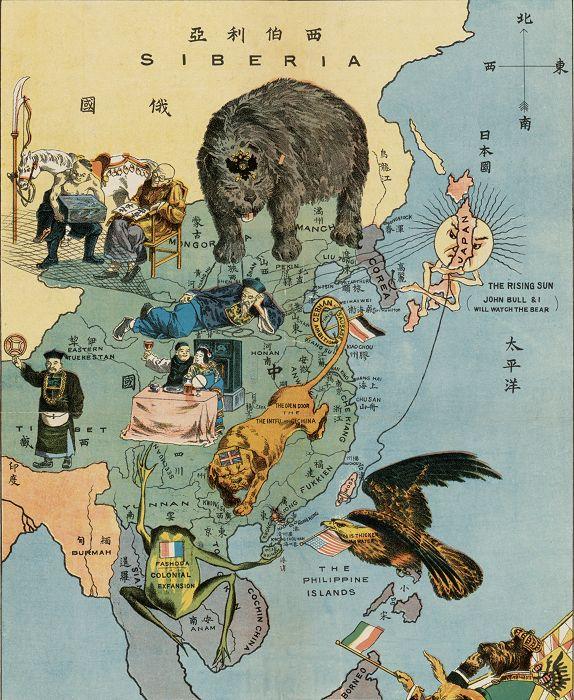
The treaty port system bolstered the spheres of influence within China where foreign governments had a free hand: France in Yunnan and Guangxi; Japan in Fujian; German in Shandong; Russia and then Japan in Manchuria; Britain in the whole Yangzi valley from Shanghai to Chongqing. There was also a network of missionary stations where isolated Christian missions were founded deep into Chinese territory; the treaty port system providing any necessary military and material support for them.
Peak and decline
The Boxer Rebellion and the Siege of the Legations ➚ in Beijing put the foreign powers in complete ascendency over a weak Qing government. They could demand control over whichever cities they liked. In 1898 they started demanding not just cities but extensive areas of land as well.
By 1900 most large cities in China had an enclave, the exception being the north-west of China and Beijing itself. The number of treaty ports reached its peak at about this time. Unofficial shanty towns for local Chinese grew up around them. In 1906 The total Chinese population within treaty ports was estimated at nearly 7 million; but foreigners account for only about 36,000 (Japanese 40%; British 24%; American 9%; Portuguese 8%). They provided a place of refuge from government, out of the reach of the Imperial regime. A free press and free access to western literature made the larger enclaves hot beds of revolution. It is easy to understand why these population centers, immune to Chinese laws, posed a threat to the government.
North China Daily News of Shanghai (c.1900)
The Insatiable Greed of Western Nations : Let China Beware!
Foreigners have for many years united themselves, and have been laying their plans with regard to China. Originally they availed themselves of the plea of the mutual advantages arising out of commerce to induce China to open treaty ports at which they could trade. Next, under pretexts of various losses, in order to enrich themselves, they compelled China to pay certain indemnities. To-day they are mooting the questions of railways and mines, and using them as a pretext to get our country from us. Their purpose is, trusting in their strength, to partition out and divide among themselves our country.
Like chess-players, who place their pieces preparatory to attacking and vanquishing the enemy they have arranged their forces. Like fishermen, who first of all silently throw the net into the water and then gather out the fish, they are preparing to catch China. They believe they have, and perhaps do possess, the ability to divide China like a watermelon. They have already seized and they hold the most important positions with a view to this end. First by insinuating that mutual gain would result therefrom, they have arranged treaties with us, which was obviously the beginning of our calamities.
In the present dispute between Russia and England, ruin for China lurks. In reality it is only a quarrel about the partition of China. Indeed, the surrounding circumstances are converging to this partition. Foreigners are ever scheming for this. Their discussions tend to the same results. The signs of this impending calamity, moreover, are all too apparent within our borders. But the opportunity to partition and snatch from us our country will be made by outsiders.
If, then, China is to regain her original power, she must arouse herself and mend her ways. If she exerts herself to her full ability, she will then be able to foil the strategies of her enemies; if she will but exert herself to any extent, she can ward off, for a time at least, the actual partition. Then the violence with which foreigners insult us, although it appears to be all-powerful, will turn out not to be so, and our distress will really be no distress at all.
But alas! there is a fatal tranquility that arises from a condition of coma, a darkness arising out of a state of crass ignorance, so that, though dangers like falling mountains threaten us, many seem unable to observe the impending ruin. True, there are earnest scholars of the Empire, but they only smite the breast and weep tears of blood more bitterly, indeed, than in the days of the tribulation of Ji. Let our readers clearly understand that the attitude of all foreigners toward China is guided by one principle; they unite their energies and combine their forces in order to gratify their one ambition, which is to partition and rob us of our country.
The economic viability of the treaty ports was dealt a massive blow by the opening of the Trans-Siberian Railway ➚ in 1904 from Moscow to Vladivostok. Goods could now be transported much faster by rail than by sea. Even though the number of ports continued to grow, they began to struggle financially and some were never even developed.
The Chinese Republican movement was fueled by a rising tide of resentment of this slicing up of China ‘like a melon’. They could see that the numerous enclaves posed an obstacle to national integration and sought their immediate return to Chinese rule. When the Republic was founded in 1912, the up-swelling of anti-foreign sentiment led to riots. The new republican regime swept away the old, draconian laws that had given some legitimacy to the demands for Extra-Territoriality. China was a new modern state and treaty ports were now an anachronism. Britain after some military posturing voluntarily gave up Hankou, Hubei and Jiujiang, Jiangxi. There then followed other cities: Zhenjiang, Jiangsu; Xiamen, Fujian and Weihaiwei, Shandong in 1930. Riots and banditry made life for foreigners increasingly hazardous. In 1923 passengers on the Blue Express train on route from Shanghai and Beijing were taken hostage in the Shandong mountains and held at Lincheng for a month.
In the 1920s, even though Chiang Kaishek wanted all foreign run territory to be returned to China his reliance on foreign aid weakened his position. It was only when the Allies needed China to throw her weight against Japan that they conceded ground. In 1943 the Allied leaders at the Cairo conference ➚ agreed that on victory all foreign enclaves would be returned back to Chinese control. Although full control was lost, the foreign powers still maintained a high level of control particularly in Shanghai. It was Mao's PRC that put an end to all foreign influence, shutting the doors to the rest of the world for over 20 years.
Development of Treaty ports in maps
1840

1850
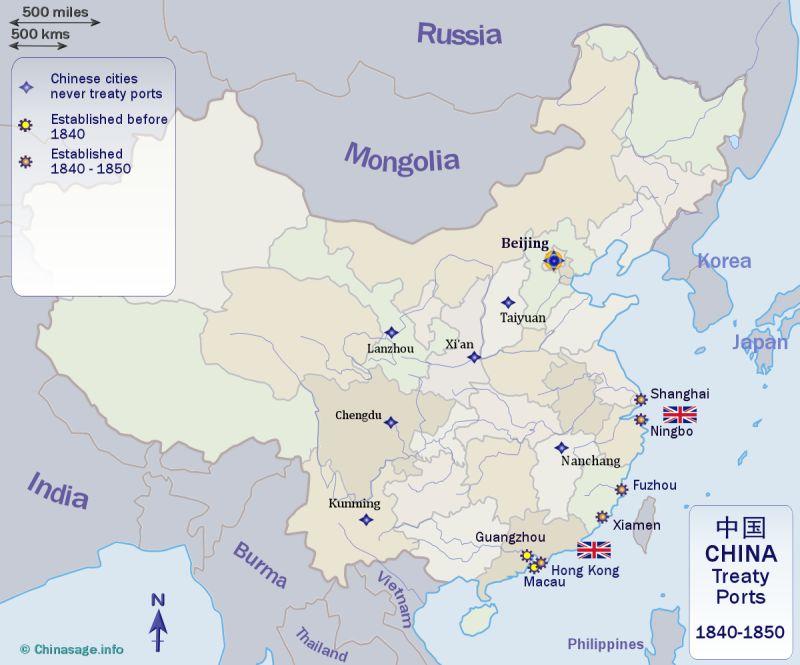
1860
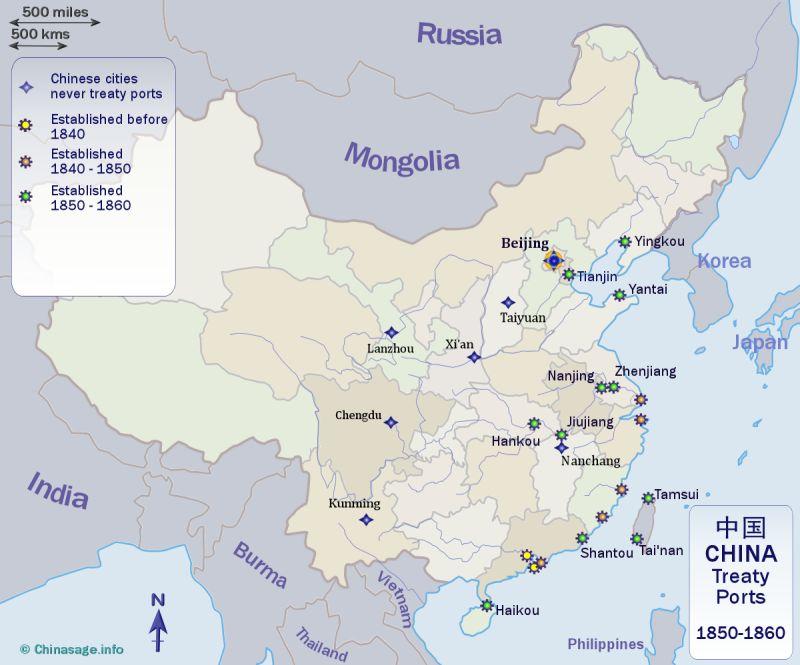
1900
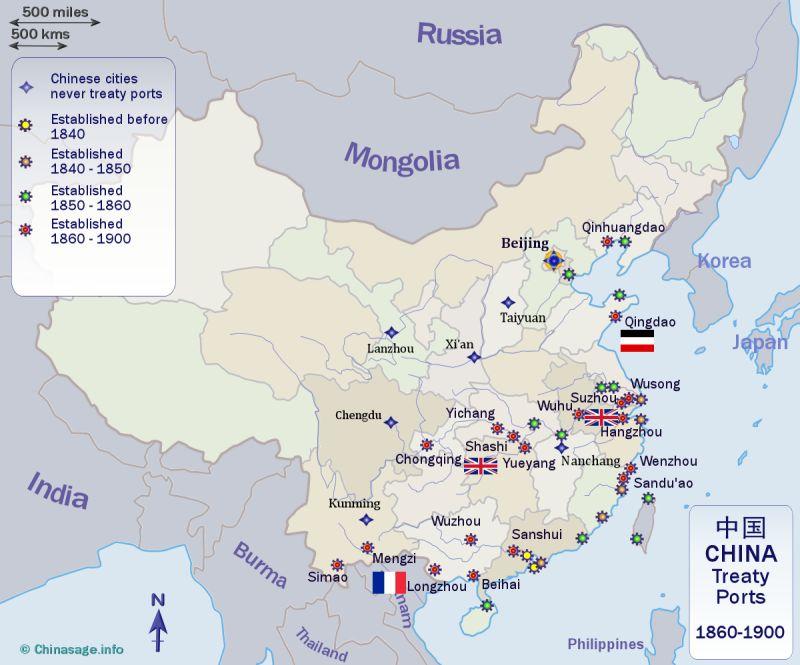
1920

Foreign occupation of China - A time line
Here we present a time line of important events concerning foreign contacts with China and the setting up of the treaty ports and concessions.
| 1516 | Portuguese explorer Rafael Perestrello ➚ landed on southern Chinese coast. |
| 1517 |
Portuguese Fernão Pires de Andrade ➚ arrived at Guangzhou Canton WG and negotiates with local merchants. Early trading begins on islands in Pearl River Estuary. Portuguese settlements founded at Xiamen Amoy WG and Ningbo. |
| 1521 | The Ming dynasty navy beat the Portuguese at Battle of Tunmen ➚. Envoy Tomé Pires ➚ denied audience with the emperor and then sent to Guangzhou and there died in prison. |
| 1542 | At Ningbo, in reprisal against Portuguese raids into neighboring towns, a large Chinese army massacred ➚ the foreign community at Ningbo, 800 killed and the fort was raised to the ground. |
| 1544 | Portuguese ejected from port of Xiamen. |
| 1557 | Portugal granted land and permission to erect warehouses at Macau, probably as a reward for Portuguese defeat of Japanese and Chinese pirates in the estuary. It was not a formal colony, the land was still ‘owned’ by China. |
| 1565 | Andrés de Urdaneta of Spain starts lucrative trade across the Pacific between Manila, Philippines and Mexico. The goods then went overland and onwards across the Atlantic to Europe. Manila in turn received goods from Chinese boats. The Spanish did not have a port in China itself. The galleons were huge - 2,500 ton - and carried the newly found silver in Mexico and south America to pay for silk, porcelain and spices. The vast riches held in the great ships made them prey to countless pirates in the Philippines and along Californian coasts. |
| 1579 | Queen Elizabeth I of England sends out an embassy to China but the Portuguese blocked entry and her letter never reached China. |
| 1582 | Portugal pays 500 taels in silver as rent for Macau. |
| 1603 | In Manila, the Spanish put down a revolt by the Chinese who greatly out-numbered them and then massacred the whole Chinese population of about 20,000 people. |
| 1637 |
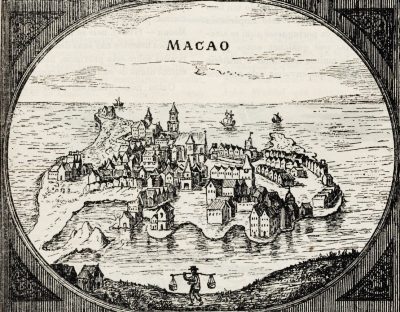 |
| 1684 |
English East India Company ➚ establish first factory (warehouse) at Guangzhou. During the 18th century the East India Company also operated a large warehouse at Macau. |
| 1730 | The Qing government decreed that all trade must be through Guangzhou, with very limited Spanish trade at Xiamen. Foreign ships were only allowed into harbor during the trading season, at other times they had to stay at Macau. Foreign hostility to these restrictions to trade grew during the period 1760-1842. |
| 1740 | The Chinese community at Batavia ➚ in Java massacred by the Dutch after they started a revolt over poor pay and conditions. Over 10,000 Chinese people were killed. |
| 1756 | Frederick Pigou a director of the English East India Company suggested Shanghai a suitable site for development. |
| 1808 | Macau occupied by a British garrison on the pretext of possible attack by France during the Napoleonic wars ➚. At the end of the war Britain emerged as the super-power in the area, master of the seas and now rich from trade with India. She looked on China as the next India, ripe for exploitation. |
| 1815 | The Spanish Galleon trade between Manila to Acapulco came to an end with the independence of Mexico and the direct trade with China by European countries through Macau. |
| 1833 | The English East India Company ➚ is forced to break its monopoly of UK - China trade. This opened up the market to independent traders who increased the ineffectively regulated opium trade with China. |
| 1839 |
The British community in Guangzhou forced to move to Macau because of the trade in Opium was declared illegal. 13th Oct. As a reprisal the British capture the port of Ningbo. |
| 1841 |
Jan. Hong Kong Island partially ceded to Britain. 27th Aug. British capture port of Xiamen during the First Opium War. Shanghai pays ransom of 1,000,000 taels in silver to escape British bombardment. |
| 1842 |
10th Mar. Chinese attempt to retake Ningbo from British at night but rebuffed with loss of many Chinese lives.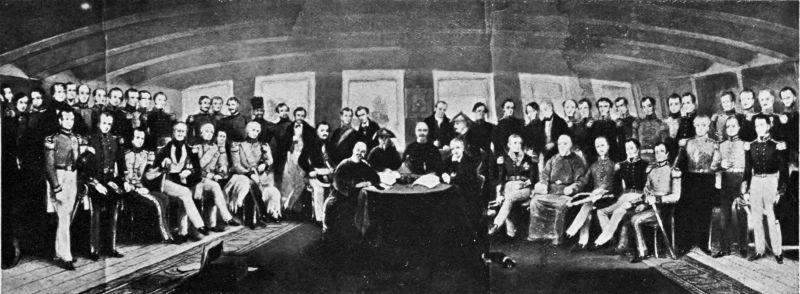 The treaty formally opens the first proper ‘treaty ports’ for British trade: Guangzhou, Shanghai, Xiamen, Fuzhou and Ningbo. Hong Kong island fully ceded as a colony. Trade now starts to move from Macau to Hong Kong as it was under firm British jurisdiction. Xiamen (Amoy) had had a long history as a port going back to 800CE; Gulangyu Island just off the mainland was the main site of foreign settlement. At Shanghai the foreign powers chose land between the Chinese city and Suzhou Creek (Wusong River); this waterfront eventually became the famous Bund ➚ area. To begin with it had three foreign concessions: British, French and American located along the Huangpu River. The French chose the land to the south nearer Chinese city, while America chose land on the north side of the creek. August. The British navy sailed up Yangzi river as far as Nanjing and the port of Zhenjiang captured which is at junction with Grand Canal. |
| 1843 |
Unrest in Guangzhou over the terms of the Treaty of Nanjing. A poster was produced decrying the actions of the British:
“The injuries, deceits, cruelty and evil acts of the British resident barbarians are as numerous as the hairs of the head. Now they seek to coerce the government. They have long wished to enter our city; and our governors, from their kindness and benevolence, have given in and issued a proclamation granting permission to enter. They have not considered that the British barbarians, born and raise in noxious regions beyond the bounds of civilization, have the hearts of wolves, faces of tigers and cunning of foxes, plan to take our province and only seek to enter the city to spy out the land.”British Captain Balfour ➚ sent to Shanghai to inaugurate settlement. By the end of 1843 there were only 23 foreign residents and their families. Agricultural land at Shanghai bought from local Chinese for residences and warehouses. Initially the international settlement was under British protection, most notably during the Taiping Rebellion. 5th April. Ningbo (Ningpo) in Zhejiang inaugurated as British colony. |
| 1844 |
Portugal seeks more autonomy for Macau but blocked by Chinese authorities. 3rd July. Treaty of Wangxia (Macau) ➚ American Caleb Cushing ➚ negotiates same trading rights with China as given to Britain. |
| 1845 | Start of the Chinese coolie trade where immigrants, often under duress were shipped to work as slaves (in all but name) at plantations and mines in America, Peru, Java and Hawai'i. |
| 1849 | Macau Governor Amaral ➚ tortured and decapitated by Chinese in retribution for building road over a Chinese graveyard. Gold rush in California attracted many Chinese immigrants. |
| 1850-64 |
During the Taiping Rebellion, many treaty ports in southern China came under threat. Shanghai was put under British military jurisdiction. The Chinese part of Shanghai was held by the rebels 7th Sept 1853 to 17th Feb 1855. Many Chinese cities were attacked and decimated with great loss of life. Foreign trade was severely disrupted. Eventually the foreign powers took sides with the Qing government and helped bring about its victory. The conflict reinforced the view of foreign powers that they needed control of ports in China. |
| 1854 |
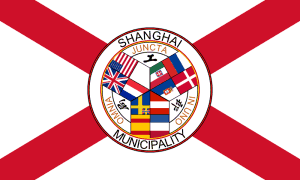 |
| 1855 | Shanghai trade began to flourish, it had 438 visits by ship (72% British) with 76 million tons of tea and 55,000 bales of silk exported. Shanghai's British and International concessions are set at 9 sq miles [23 sq kms] and the French concession 4 sq miles [10 sq kms]. |
| 1856 | 15th Dec. Chinese people attack foreign residences in Guangzhou fueled by resentment of the terms of the Nanjing treaty. |
| 1857 |
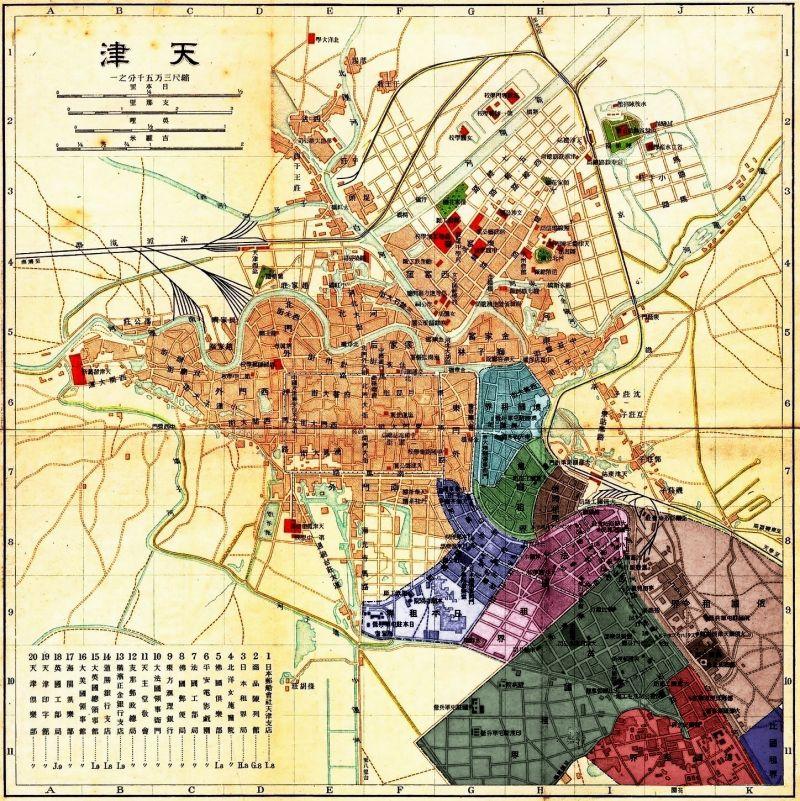 June. On China's defeat in the Second Opium War the Treaty of Tianjin ➚ is signed and more control is ceded (there were actually four treaties not just one). Great Britain, France, Russia, and the United States were given the right to have permanent legations in Beijing. Permission given for foreigners to travel everywhere in China including on religious missions. Limit on tariffs was set at 5% and the Yangzi river was opened up for trade. “British merchant ships shall have authority to trade upon the Great River”. Most favored nation treaties give America and other countries equal rights to Britain. Eleven new treaty ports created, four of them inland including Hankou, Nanjing Shantou (Swatow), Guangdong a small village until opened up to trade. The strategic city of Zhenjiang captured by Taipings 1st April 1853 and heavily damaged. Hankou became more important and developed as a treaty port (now part of Wuhan). Haikou (Qiongzhou) , Hainan Niuzhuang (Yingkou), Liaoning opened 1861 Yantai (Zhifu), Shandong (aka Chefoo) opened 1861 Tamsui, (Taipei) Taiwan opened Tainan, Taiwan opened Nanjing, although not strictly a treaty port, is mentioned in the Tianjin treaty. Nanjing was then the Taiping capital and not under Qing control and there was much destruction before it was recaptured - most of its trade moved to Shanghai. Macau was formally leased to Portugal and Hong Kong island ceded as a British possession. |
| 1858 | 7th Nov. Lord Elgin ➚ leader of the British expedition reaches Hankou. |
| 1859 | Shamian Island (Shameen) divided between French (40%) and British (60%) concessions. It was a sandy bank just to the south of the city of Guangzhou. |
| 1860 |
Yantai, Shandong (Chefoo) occupied by French on their way to Beijing. Convention of Beijing ➚ opens Tianjin as a treaty port with concessions for Britain; France and the United States. Ceded Kowloon, Hong Kong to Britain in perpetuity and legalized the coolie trade - 'indentured' Chinese laborers in plantations, mines and on foreign ships. Foreigners allowed to travel unimpeded throughout China. |
| 1861 |
12th Feb. British expedition to open consulates along the Yangzi at Zhenjiang, Jiujiang and Hankou. 11th Mar. Hankou, Hubei opened to foreign trade by British. Jiujiang (Jiangxi) opened by Britain but heavily damaged during the Taiping Rebellion. It remained a minor port mainly exporting tea. 9th Dec Ningbo captured by Taipings, but here they tried to keep on good terms with foreigners. |
| 1862 |
Final negotiations by Portugal to buy the land at Macau end in failure. Jan. Shanghai under Taiping attack. |
| 1863 | British and American concessions at Shanghai merged to form an autonomous International concession. General Gordon helps with defense against Taiping rebels. |
| 1865 |
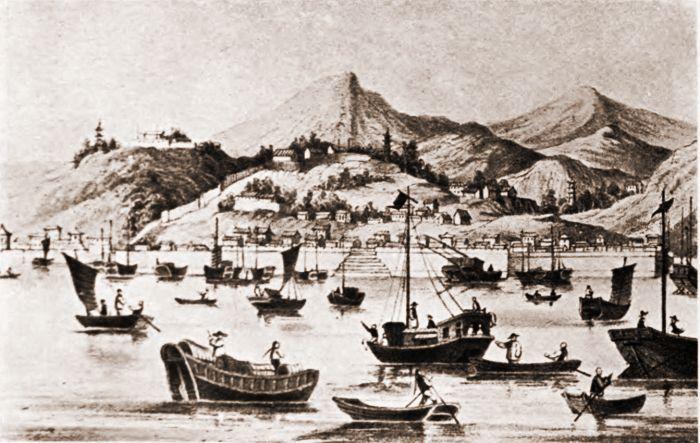 |
| 1867 |
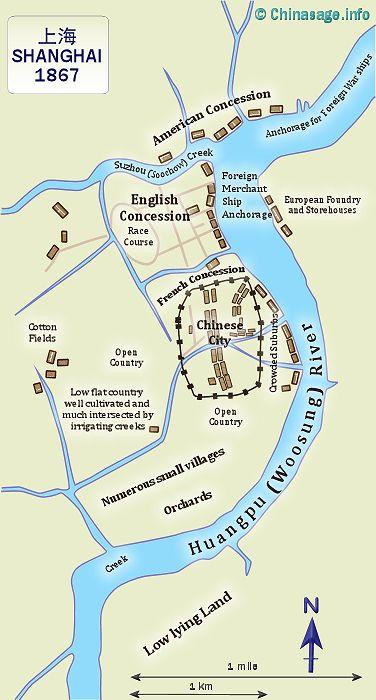 |
| 1868 | Revolution in Japan. The Meiji restoration quickly turns Japan into a modern westernized nation. Within 30 years Japan had sufficient military might to defeat China. |
| 1876 | 21st Aug. Chefoo Convention ➚ (aka Treaty of Yantai) between China and Britain, this was a response to the murder of Captain Margary ➚ while surveying the route for a new railway into Burma (and ultimately to India). The convention agreed punishment of the perpetrators and restitution. It also outlawed some levies and taxes imposed by China on trade. New treaty ports were opened including Yichang (Hubei), Wenzhou (Zhejiang) (but foreign presence never established), Beihai (Guangxi), Wuhu (Anhui) . The horrid coolie trade came to a virtual end by agreement between the Chinese and foreign governments. |
| 1880 | At Tianjin, the United States gives up their concession, but in the 1890s small concessions in the city were given to Japan and Germany. It becomes the city with the most concessions (eight) demonstrating its importance as the chief port in northern China. |
| 1884 | French troops attack the Gulf of Tonkin in northern Vietnam and make Hanoi the center of the French Indo-China Empire. |
| 1885 |
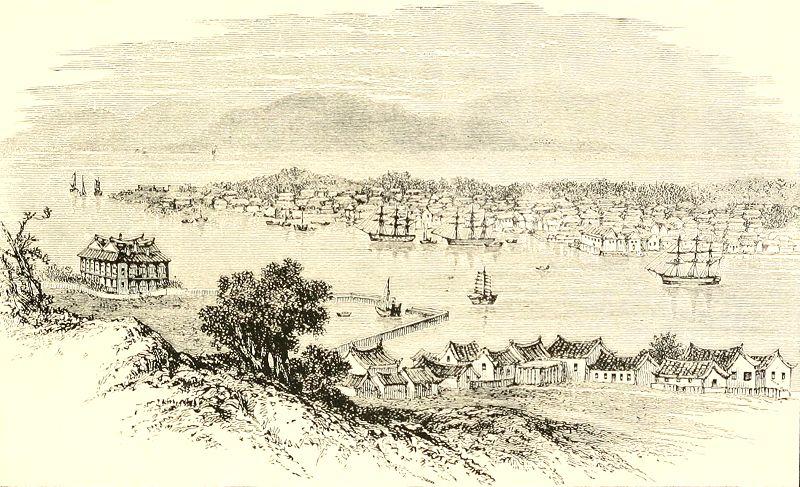 |
| 1895 |
Convention on Commerce ➚ with France opened ports in French sphere of influence: Longzhou (Guangxi); Mengzi (Guangzi); Pu'er (Simao) (Yunnan); 17th April. Treaty of Shimonoseki ➚ at the end of the Sino-Japanese War, China gave concessions at Suzhou (Jiangsu), Hangzhou (Zhejiang), Shashi (Hubei), Chongqing. Lushunkou (Port Arthur). The Pescadore islands and Taiwan given as possessions to Japan. 23rd April. Triple Intervention ➚ of Russia, France and Germany seek to modify terms of the Treaty of Shimonoseki. As a result Lushunkou (Port Arthur) taken from Japanese control and leased to Russia as a concession. Germany took control of Qingdao area in Shandong. At this time Japan was receiving British support as a counterweight to Russian expansionism. The Triple Alliance marks the start of a full-scale scramble for concessionary deals within China. |
| 1897 | Tengchong (Tengyue) (Yunnan); Sanshui (Guangdong); Wuzhou (Guangxi) opened to British trade. |
| 1898 |
At the start of the Boxer Rebellion the Qing government was particularly weak and gave away further concessions. There was a major flood of the Yangzi River in August leading to many deaths, this was followed in 1899 by drought. Britain remained the world’s only superpower. China voluntarily offered concessions (non-treaty ports) including Qinhuangdao (Hubei). However the main development was the leases for large areas of land not just enclaves in cities. March. Jiaozhou Bay, Shandong, around Qingdao, was leased to Germany, 193 sq miles [500 sq kms] for 99 years. Also Liaodong Peninsula, Liaoning was leased to Russia, 1,438 sq miles [3,724 sq kms] for 25 years. May. Guangzhouwan (Guangzhou Bay), Guangzhou leased to France,325 sq miles [842 sq kms]. for 99 years. June. The Anglo-Chinese Convention ➚ New Territories, Hong Kong leased to Britain, 306 sq miles [793 sq kms] for 99 years. This agreement led to some local unrest. July 1st Weihaiwei, Shandong leased to Britain, 552 sq miles [1,430 sq kms] for as long as Russia held Lushunkou (Port Arthur). |
| 1902 |
Jiangmen (Guangdong) opened to foreign trade. After end of the Boxer Rebellion Tianjin opens up concessions for Belgium, Italy, Russia and Austria-Hungary as well as the original nations. Japan signs an alliance with the UK ➚ and then served as Britain's chief ally in northern China area up until 1939. |
| 1904 |
The Treaty of Lhasa ➚ sets up British presence at Yadong on Tibet's border with India. Also at Gyangze and Gartok (on the upper Indus river). Changsha (Hunan), Shenyang (Mukden), Liaoning opened to foreign trade. British influence in China reaches its zenith. The Trans-Siberian railway through Russia opened on 21 st July making the overland route for goods much faster and cheaper, this made the sea ports much less important. |
| 1906 | Chinese offer to open Jinan, Shandong for trade. |
| 1907 |
Chinese offer the city of Nanning, Guangxi for trade but the city was never developed. Many ‘treaty ports’ opened mainly in Russian controlled Manchuria including Qiqihaer; Heihe (Aigun); Harbin; Jilin and Manzhouli. |
| 1911 | Over 50 treaty ports are open (representing the peak level) and up to 100 if 'voluntary' and informal ports are counted. |
| 1912 | On the foundation of the Republic of China some treaty ports of little value to foreign powers were returned including Xiamen. |
| 1914 | German lease of Qingdao taken over by Japan when Japan joins the Allies against Germany. |
| 1917 | Germany and Austro-Hungary lose their concessions at Tianjin when China joins the Allies (Britain, France, Germany) in the First World War. |
| 1919 | 28th June Treaty of Versailles ➚ returns Germany's Shandong concessions as a ‘possession’ to Japan and not to China as China had expected. This proved a major source of grievance that led to the May 4th movement. China refused to sign the treaty ➚ but Shandong was effectively leased to Japan as a compromise. |
| 1920 |
At Shanghai the population in the French and International settlement combined reaches 60,000 foreigners with 300,000 Chinese; the wider Shanghai city including land outside the concessions now 3,000,000. The Chinese were given a small representation on the Shanghai Municipal council. Republican China did not recognize rights of the new Communist regime in Moscow so the Russian Tianjin concession was lost. |
| 1922 | Japan gives up the lease of Qingdao, Shandong. |
| 1924 | Russia, as a friendly Communist neighbor, gives up rights to all concessions except for the Chinese Eastern Railway through Manchuria. |
| 1925 | 23rd Jun. After British troops shoot at Chinese people at Shamian Island, Guangzhou British goods were boycotted in southern China until 1927. |
| 1927 | Local hostility under the new government leads to British concessions at Hankou, Zhenjiang and Jiujiang being relinquished; they had lost their strategic value. Britain, however, maintained an important base at Hankou to control traffic on the Yangzi river. |
| 1928 | Mexico gives up special treaty rights and concession at Tianjin. |
| 1929 | Aug. Belgian concession at Tianjin relinquished. |
| 1930 | 17 Sep. Britain gives up concession at Xiamen (Gulangyu Island) and Weihaiwei, Shandong. Weihaiwei was leased only so long as Russia controlled Lushunkou (Port Arthur). |
| 1937 | Start of Japanese occupation of China. The Japanese avoid attacking the foreign concessions, but the Chinese parts of cities were heavily damaged, as at Guangzhou and Tianjin. |
| 1940 | Only Italy, United States, France and Britain retain their treaty rights. |
| 1941 | 8 Dec. Japan occupies Shanghai bringing to an end all the foreign concessions there. |
| 1939-1945 | During World War 2 Macau remained a neutral territory. Hong Kong occupied by Japan 1941-45. In exchange for Chinese support in the war, United States and Britain at the Cairo Convention ➚ agree to give up remaining treaty rights at the end of war notably Shanghai and Guangzhou. During the war Fujian province under Japanese control. |
| 1945 | At the end of World War 2 Japan loses all its treaty rights including the Hankou concession. Italy also gives up rights to Hankou; Shanghai and Xiamen. Russia leases a base at Lushunkou (Port Arthur). |
| 1946 | France gives up all treaty rights including Guangzhouwan and Hankou in exchange for French control of northern Vietnam. Only Hong Kong and Macau remained foreign controlled. |
| 1954 | Russia relinquishes leased base at Lushunkou (Port Arthur) Liaoning. |
| 1984 | Britain and China agree the return of Hong Kong in 1997 in the Joint Declaration ➚. |
| 1997 | 30th Jun. Hong Kong no longer a British colony and enters 50 years of transition under two systems. |
| 1999 | 20th Dec. Macau no longer a Portuguese colony and enters 50 years of transition. The last territory leased or owned by a foreign country in China is now back under Chinese governance after 442 years. |